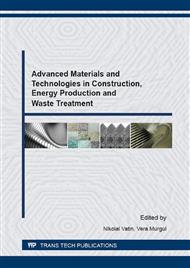[1]
P. F. Drucker, Innovative and Entrepreneurship, Practice and Principles, Harper & Row, Publishers, Inc. (1985).
Google Scholar
[2]
A.D. Ishkov, M.Y. Mishlanova, K.P. Grabovyi, The Organization of Innovative Activities of A Construction Company, in: International Journal of Applied Engineering Research, 2016, Vol. 11, № 3, pp.1676-1679.
Google Scholar
[3]
V.A. Ilyichev, Biosfernaya sovmestimost': Tekhnologii vnedreniya innovatsiy. Goroda, razvivayushchie cheloveka, Librokom, Moskva, (2011).
Google Scholar
[4]
S. D. Mezentsev, D. S. Gavrikov, Architecture of Modern Timber-Framing Houses, in: Indian Journal of Science & Technology. Volume 8, Issue 30, November 2015. - Information on http: /www. indjst. org/index. php/indjst/article/view/86530.
DOI: 10.17485/ijst/2015/v8i30/86530
Google Scholar
[5]
M.V. Loseva, T.V. Chesnokova, M.V. Toropova, Otsenka ekologichnosti stroitelnyih materialov, in: Goroda Rossii: problemyi stroitelstva, inzhenernogo obespecheniya, blagoustroystva i ekologii XVII, Mezhdunarodnaya nauchno-prakticheskaya konferentsiya: sbornik statey, Penza, 2015, S. 62-65.
Google Scholar
[6]
M.S. Panteleeva, V.N. Tsupikova, Upravlenie zatratami pri realizatsii stroitelnogo proekta s pomoschyu innovatsionnoy tehnologii «karkasno-solomennyiy dom», in: Nauka i obrazovanie: sovremennyie trendy, 2015, 2 (8), S. 449-458.
Google Scholar
[7]
E.P. Chernyishova, R.R. Sabirov, V.E. Chernyishov, Zemlyanoe stroitelstvo kak sredstvo usileniya bezopasnosti zdaniy i sooruzheniy, in: International scientific review, 2016, 2 (12), S. 299-302.
Google Scholar
[8]
I.H. Nanazashvili, A.A. Sokolov, R.A. Marchenkov, Drevesnyie othodyi - vtoraya zhizn. Arbolitovyie stenovyie bloke, in: Stroitelnyie materialyi, oborudovanie, tehnologii XXI veka, 2011, 7 (150), S. 24-25.
Google Scholar
[9]
Ekologichnyie stroitelnyie innovatsii. - Information on http: /dom-sweet-dom. ru/2319-stroitelstvo-innovacii. html.
Google Scholar
[10]
G. Heymel, What is What in Management Innovations – Harvard Business Review (russkoe izdanie), mart, 2006, S. 60-73 - Information on http: /www. cadrem. ru/Materials/2006/ 2006_HBR_03_What%20is%20What%20in%20Management%20Innovations/What%20is%20What%20in%20Management%20Innovations. shtml.
Google Scholar
[11]
Е. P. Torrance, Guiding creative talent Englewood Cliffs, WJ: Prentice-Holl, (1964).
Google Scholar
[12]
E. V. Getmanskaya, Lichnost: kreativnyie harakteristiki, in: Vestnik Moskovskogo gosudarstvennogo gumanitarnogo universiteta im. M. A. Sholohova, Pedagogika i psihologiya, 2010, 1, S. 25-33.
Google Scholar
[13]
J. Roger, P. McWilliams, Life 101, Los Angeles, Calif.: Prelude Press, (1990).
Google Scholar
[14]
Information on https: /en. wikipedia. org/wiki/Main_Page. _Louis Pasteur.
Google Scholar
[15]
R. Florida, The Rise of the Creative Class Basic Books (2003) - URL : https: /www. os3. nl/_media/2011-2012/richard_florida_-_the_rise_of_the_creative_class. pdf.
DOI: 10.4000/nrt.2971
Google Scholar
[16]
M. E. Porter, On Competition, A Harvard Business Reviev, 2008, 576 p.
Google Scholar
[17]
V.A. Koshelev, Osobennosti innovatsionno-investitsionnoy deyatelnosti v zhilischnom stroitelstve, in: Vest. Samar. gos. ekon. un-ta. Samara, 2010, 12 (74), S. 29-32.
Google Scholar
[18]
N.F. Vishnyakova, Psihologicheskie osnovyi razvitiya kreativnosti v professionalnoy akmeologii: Diss. d-r. psihol. nauk : 19. 00. 13, Moskva, 1996, 394 c.
Google Scholar
[19]
A.D. Ishkov, The features of self-organization of adults studying at a technical university, in: Procedia - Social and Behavioral Sciences, 2014, V. 142, pp.54-58.
DOI: 10.1016/j.sbspro.2014.07.587
Google Scholar
[20]
B. Batinic, H. G. Wolff, & Ch. M. Haupt, Construction and factorial structure of a short version of the Trendsetting Questionnaire (TDS-K): A cross-validation using multigroup confirmatory factor analyses, European Journal of Psychological Assessment, 2008, 24(2), 88-94.
DOI: 10.1027/1015-5759.24.2.88
Google Scholar
[21]
A.A. Karmanov, Tsel-sredstvo-rezultat. - Information on http: /azps. ru/tests/tests_csr. html.
Google Scholar
[22]
N.F. Vishnyakova, Creativity - Information on http: /docpsy. ru/testy/diagnostika-intellekta-i-kreativnosti/3910-test-kreativnost-vishnjakova-n. html.
Google Scholar
[23]
Metodika Budassi. Test na samootsenku lichnosti - Information on http: /hr-portal. ru/tool/metodika-budassi-test-na-samoocenku-lichnosti.
Google Scholar
[24]
T. N. Magera, Аktual'nye kompetentsii studentov i prepodavatelej nauchno-issledovatel'skikh institutov, in: Internet-vestnik VolgGАSU, Ser.: Politematicheskaya, 2013, V. 3(28) - URL: http: /vestnik. vgasu. ru/attachments/Magera-2013_3(28). pdf.
Google Scholar
[25]
E. Shnyrenkov, I. Pryadko, The Bologna Process: exacerbation of Social competences among Civil Engineering Students, in: Procedia Engineering, 2015, V 117, S. 330-335.
DOI: 10.1016/j.proeng.2015.08.168
Google Scholar


